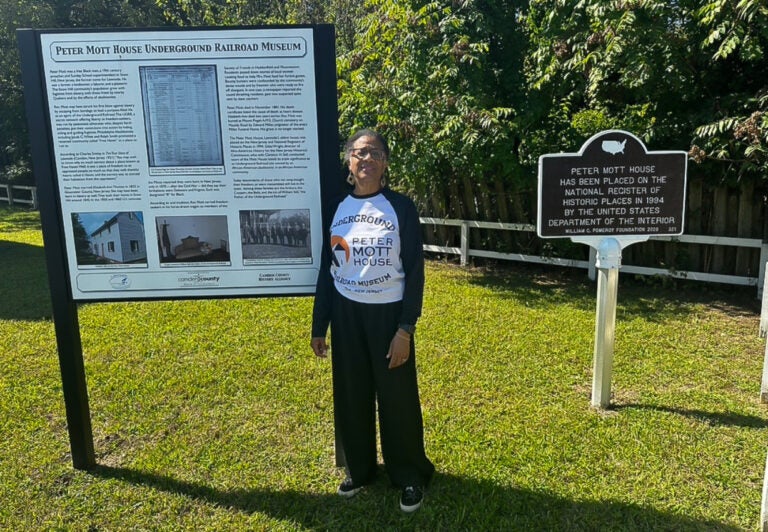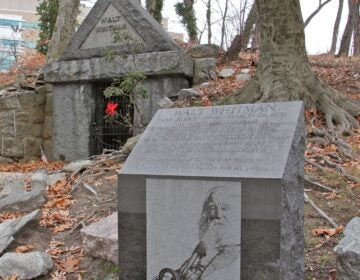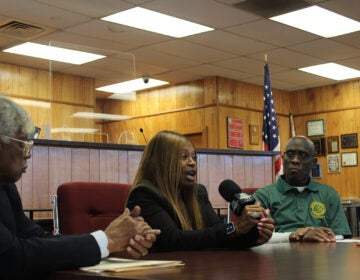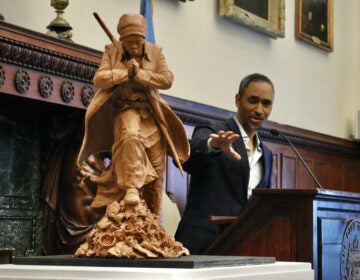Lawnside Historical Society marks 35th anniversary of preserving Underground Railroad and borough history
The organization will celebrate with new exhibits and an interpretation of Harriet Tubman.

Linda Shockley has been president of the Lawnside Historical Society since 1994 and is one of the founding members. (P. Kenneth Burns/WHYY)
From Camden and Cherry Hill to Trenton and the Jersey Shore, what about life in New Jersey do you want WHYY News to cover? Let us know.
The Lawnside Historical Society will celebrate its 35th anniversary on Sunday, Sept. 21, at the Wayne R. Bryant Community Center. In addition to new exhibits, guests will be treated to dinner and a performance by actor Millicent Sparks, who will play Harriet Tubman.
What’s the Peter Mott House?
The Peter Mott House was a stop on the Underground Railroad.
The three-floor dwelling was built by Peter Mott around 1844, with an addition erected in 1870. Once part of sprawling farmland, the house now sits within a development in a quiet cul-de-sac. The New Jersey Turnpike can be seen through a back window of the house, through the trees.
“This property fell into arrears on taxes and it was being sold to a developer who wanted to build 22 attached homes on this site,” said Linda Shockley, president of the Lawnside Historical Society.

The Narberth Development Corporation wanted to clear the plot and make way for townhouses. That’s when Clarence Still, a descendent of abolitionist leader William Still, was able to convince the developer to save the building, Shockley said.
“This started in 1989, when he first accosted this gentleman,” she said. “By 1990, we determined you have to have an organization, you have to have a nonprofit organization that can raise money to buy the house.”
The organization’s mission became to protect Mott’s legacy and the home he shared with his wife, Elizabeth. Still became the founding president. Shockley succeeded him in 1994.
The historical society received the deed to the house on Feb. 20, 1992, according to its website. Two years later, it was added to the state and national registers for historic places. That allowed the society to collect more than $500,000 in grants and donations to pay for repairs and restorations to the property.
“We had to dig a new foundation ‘cause the house was built on sand,” Shockley said. “You know what the Bible says about the house that was built upon the sand.”
Shockley described how crews moved the house to the back of the property so they could build a new foundation for the building. They also needed to make sure that the building was restored to standards from the Secretary of the Interior.

In 2001, the Peter Mott House was opened to the public as a museum of the Underground Railroad, attracting a wide range of visitors from students to researchers. The house had undergone much needed repairs in recent years. In addition to donated furniture from the period and other artifacts, there is also a replica of the box that Henry “Box” Brown used to ship himself to Philadelphia to escape slavery in Virginia.
Stewarding history
Preserving the house is significant, according to Bart Everts, a reference librarian at the Robeson Library at Rutgers University-Camden.
“I think the Peter Mott House represents an area of Black history that maybe is not as well known,” he said.
Everts said the Lawnside Historic Society’s work is crucial at a time when the Trump administration has ordered the darker parts of American history, including slavery, removed from several national parks. A group including historians, community leaders and activists held a rally Saturday in Philadelphia to oppose changes to the slavery exhibit at the President’s House.
“These stories, as much as any time, are incredibly important to preserve and to promote, even as there’s an effort to revise them or try to lessen the impact of slavery or the role that this played in American history,” Everts said.
Camden County Commissioner Jonathan L. Young Sr. said the work the society does is important for the next generation.
“These are the things that our young Black folks need to understand and learn because they need to know what’s a part of their history,” he said, adding that Lawnside “continues to be at the forefront” on making sure the history is not erased.
“It gives us a real opportunity for folks to really hear the true story,” Young said.

Though the house is a major part of the organization’s work, Shockley, who is also a member of WHYY’s Community Advisory Board, said they are working to preserve the history of the Borough of Lawnside, which will mark the centennial of its incorporation in 2026.
“We say Lawnside is a microcosm of the Black experience in the United States,” she said.

Get daily updates from WHYY News!
WHYY is your source for fact-based, in-depth journalism and information. As a nonprofit organization, we rely on financial support from readers like you. Please give today.






